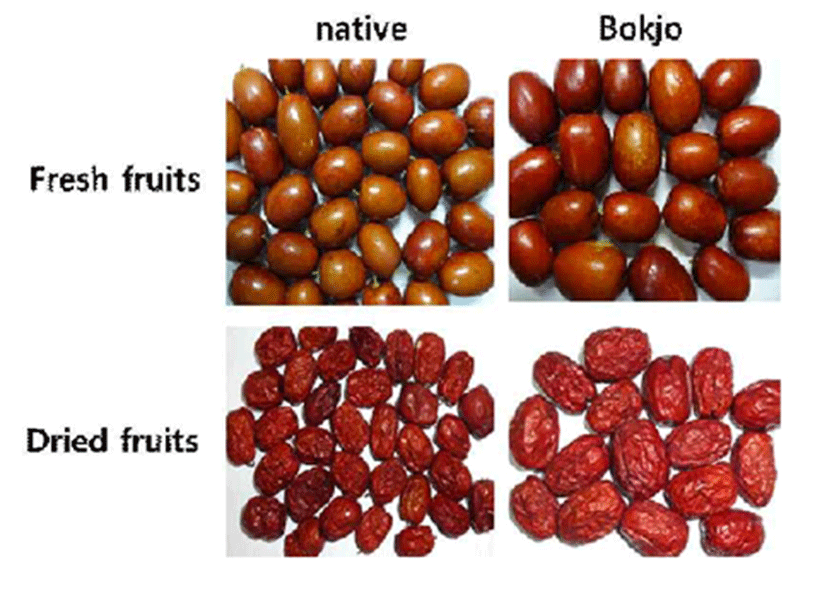Introduction
Jujube (Zizyphus Jujuba Mill) is the fruit of deciduous broadleaf tree in the Rhamnaceae family (1). With its excellent taste and aroma, jujube has been widely used as food material since the ancient times. It is a familiar fruit commonly used in wedding preparations or ancestral rites in Korea. Jujube has been widely used as digestive medicine and tonic in Oriental medicine.
Jujube is cultivated in Northern China and Korea, particularly in the Gyeongsan and Cheongsong regions of Gyeongsangbuk-do. Among different varieties, Bokjo jujube is the most cultivated one. Jujube contains carbohydrates, vitamins, and saponins (2). Their antioxidant effect, anti- allergy effect, and anti-inflammatory effect have been reported (3,4,5,6,7,8). In addition, physicochemical properties depending on the degree of maturity, drying, and processing have been investigated (9). However, comparative studies between jujube species have been seldomly conducted. Therefore, the objective of this study was to compare the characteristics of fresh and dried fruits of native jujube (also known as Yak jujube) and Bokjo jujube to provide basic data for the two species.
Materials and Methods
Fresh and dried native jujube fruits were cultivated in the Cheongsong region of Gyeongsangbuk-do. Fresh and dried Bokjo jujube fruits were cultivated in the Gyeongsan region of Gyeongsangbuk-do. They were collected in October 2014.
Randomly selected jujubes were subjected to measurements of appearance (weight, diameter, length), chromaticity (lightness, redness, yellowness), and sugar contents. The chromaticity was measured using a chromameter (CR-300, Minolta, Osaka, Japan). Sugar content was determined using a refractometer (PAL-1, Atago, Tokyo, Japan).
The hardness of fruits was measured using a rheometer (Compac-100 II, Sun Scientific Co., Tokyo, Japan). It was set up to measure 1/2 depth of the fruit flesh. The resistance of the tissue was observed when the probe was inserted at a rate of 40 mm/min. Hardness was measured and expressed as kgf.
Moisture content was measured by atmospheric pressure heating and drying. Crude fat content was measured using the chloroform-methanol extraction method. Crude protein content was determined using the Kjeldahl method. Crude ash and dietary fiber contents were measured using the Ash test method and Total dietary fiber method of the Korean Food Standards Codex of 2013 (10). Vitamin C content was analyzed using the Vitamins test method of the Korean Food Standards Codex of 2013 (10). Mineral (Ca, Fe, P) contents were analyzed using inductively coupled plasma atomic emission spectroscopy (ICP-AES) methods (11).
Results and Discussion
Native and Bokjo jujube fruits were randomly selected and their weight, diameter, and length were measured. Bokjo jujube had higher numbers in all measurements (Table 1). Its weight was twice of that of native jujube. In terms of chromaticity, Bokjo fresh jujube showed higher L*a*b* values compared to native fresh jujube. However, the difference was not significant. Fresh Bokjo jujube had more red and yellow colors but less black color (Table 2). The hardness of fresh fruit of native jujube was 2.06 kgf, which was lower than that (2.57 kgf) of Bokjo jujube (Table 1).
| Native | Bokjo | |||
| Fresh | Dried | Fresh | Dried | |
| Lightness(L*) | 25.7±3.91) | 1)97.7±4.1 | 28.8±4.3 | 103.7±4.3 |
| Redness(a*) | 10.7±2.9 | 933.0±2.3 | 12.8±2.6 | 34.2±5.7 |
| Yellowness(b*) | 11.9±2.2 | 226.1±3.7 | 12.9±3.7 | 21.7±5.3 |
The moisture, crude protein, crude fat, crude ash, and dietary fiber contents of each jujube sample were determined. In our results, the content of moisture was most high followed by dietary fiber, crude protein, crude ash and crude fat, which was similar to results of Kim et al (12). Compared to Bokjo jujube, the native jujube had higher contents for all components except moisture (Table 3). Greater differences were noted in crude protein, crude ash, and dietary fiber (Table 3). The sugar content in fresh native jujube was 29.2 °Brix, which was slightly higher than that (25.6 °Brix) in fresh Bokjo jujube (Table 3). For mineral contents, calcium (Ca) content was higher in the native jujube. Phosphorus (P) was higher in Bokjo and native jujube for fresh and dried samples respectively. However, there was no significant difference in iron (Fe) contents (Table 4).
The vitamin C contents of jujube samples are summarized in Table 5. In fresh jujube fruits, the vitamin C content in Bokjo jujube was 37.67 mg/100 g, which was higher than that (29.06 mg/100 g) of native jujube. In dried jujube fruits, the vitamin C content in Bokjo jujube was 14.50 mg/100 g, which was lower than that (16.76 mg/100 g) of native jujube. However, the difference was not significant.
| Components(mg/100 g) | Native | Bokjo | ||
| Fresh | Dried | Fresh | Dried | |
| Ca | 14.69±0.431) | 58.8±2.03 | 11.58±0.44 | 30.6±0.95 |
| P | 29.83±0.20 | 105.6±1.37 | 32.14±0.33 | 88.7±1.29 |
| Fe | 0.3±0.0 | 0.8±0.0 | 0.3±0.0 | 1.4±0.1 |
| Components(mg/100 g) | Native | Bokjo | ||
| Fresh | Dried | Fresh | Dried | |
| VitaminC | 29.06±3.501) | 16.76±1.44 | 37.67±4.18 | 14.50±2.21 |
